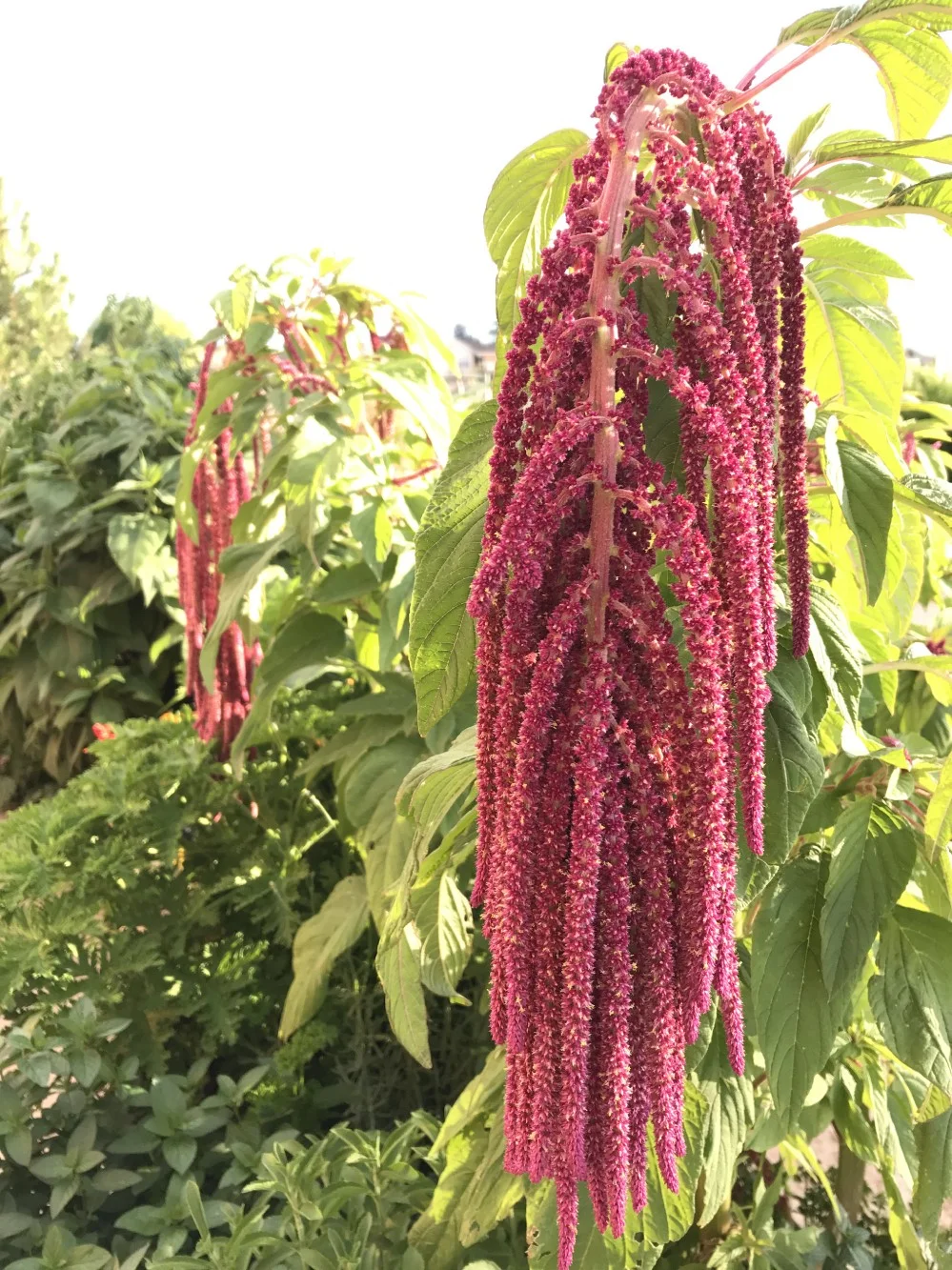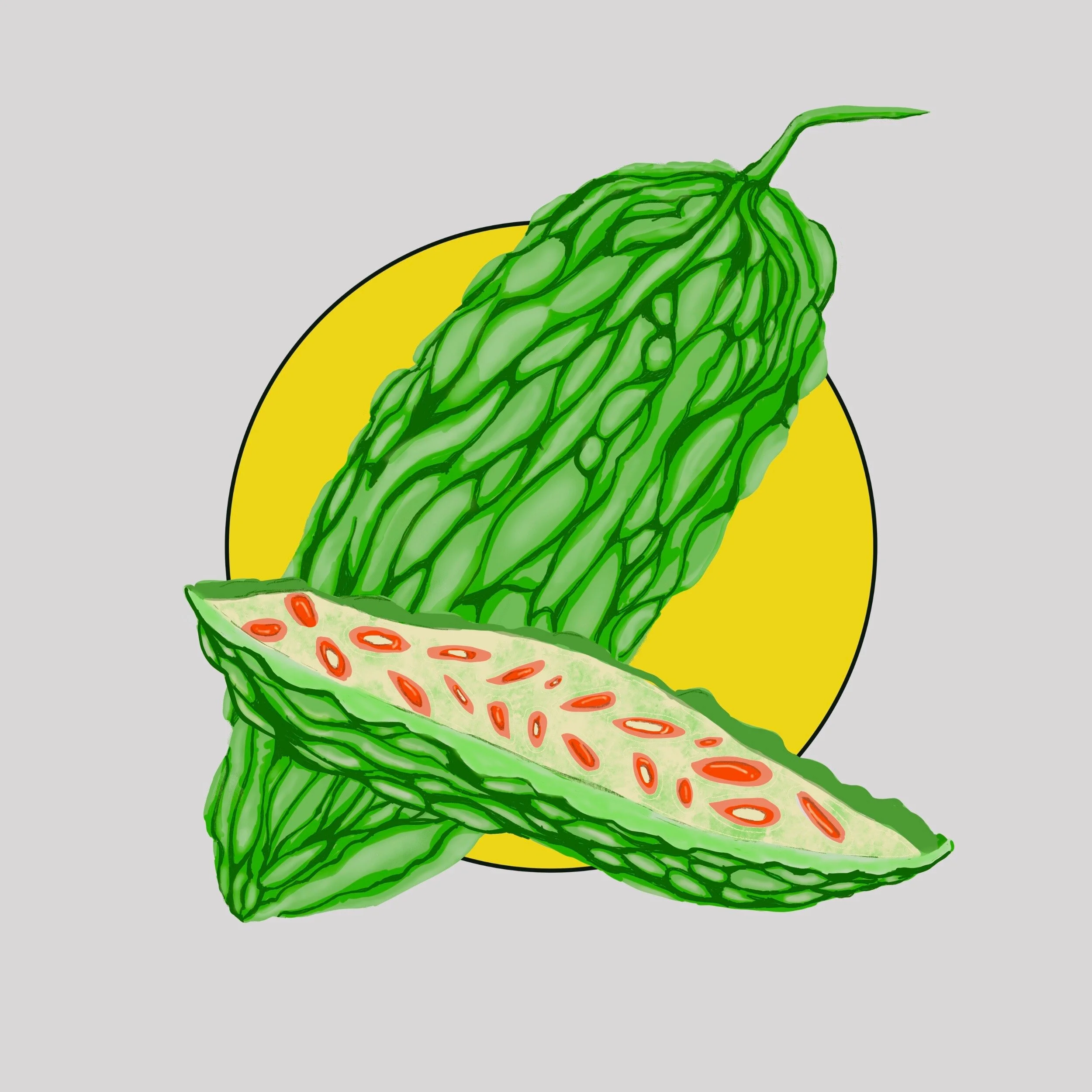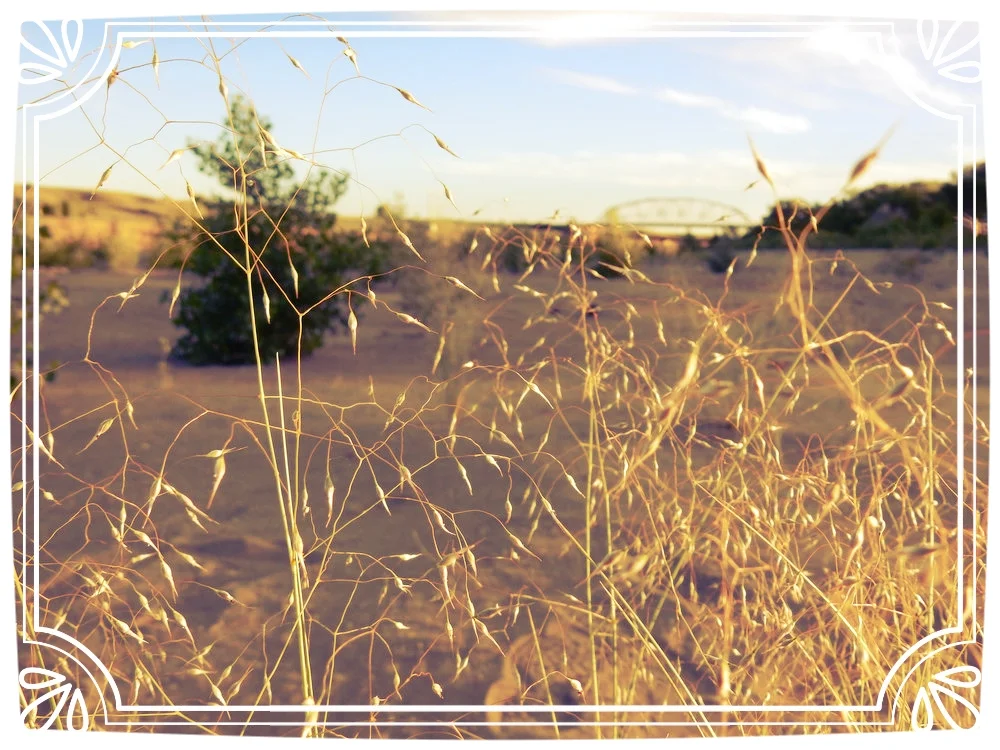Amaranths: Seed Crops with a Bloody Past
Amaranthus spp.
Image 1 (picture taken by the author): A. caudatus in our garden.
Binomial Etymology —Amaranth- is “unfading;” caud- is “the tail” (Borror, 1960). The genus name is derived from the Greek term, amarantos, meaning “unfading.”
Binomial Pronunciation — AM-uh-ranth-us Caw-DAT-us
USDA Status — Introduced (Ornamental and Food Crop).
Family — Amaranthaceae
Family Characteristics — Flowers of Amaranthacea are tightly clustered with no flower petals (only 3 pigmented bracts); the amaranthacae ovary will mature into a capsule; their flowers will have four or five stamens and sepals (Elpel, 2004).
Aliases—Inca Wheat, Love Lies Bleeding, Tassel Flower, Thrumwort, Velvet Flower; Tianximi, Ximi (CHINESE); Gegebsa (ETHIOPIAN); Queue de Renard (FRENCH); Rajgira, Ramdana (INDIA); Kiwicha (QUECHUAN); Amaranto, Ataco, Ataku, Morado, Sangorache, Quihicha (SPANISH); Callaloo (JAMAICA).
Introduction
Amaranth has a peculiarly violent history in its relations to humankind. Some say it’s seeds were mixed with human blood and formed into cakes to be eaten in a religious sacrament. Some say its cultivation and possesion were once forbidden under the penalty of death. In literature, it’s unfading flowers have long been equated with immortality or a love without hope. The name itself, Amaranth, is derived from the Greek term, amarantos, which means “unfading.”
Outwardly betraying amaranth’s violent history, A. caudatus has a surreal ability to fill an observant mind with words and phrases not commonly associated with beauty. Their flowers appear as boneless and bloody arms resigned to the unkindness of wind… squid’s tentacles… a sanguine gush of flaccid tails. It’s obvious that this plant can elicit an embarrassing supernova of dark prose if you allow your words to wander with it for awhile.
In this exploration, we will try and find extraordinary evidence to back up some of the more outrageous storys involving amaranth while zeroing in on one of its more striking members, A. caudatus.
Image 2 (taken by the author): A. caudatus flower detail.
Habitat
This is a cultivated food crop.
Edible Uses
Amaranth seeds can be heated and popped like popcorn with butter and salt. The popped seeds can also be eaten with a little honey and made in to various confections or even eaten as a breakfast cereal.
The young leaves of A. caudatus are an important food crop for the Kusume, Derashe and Gamo peoples of Ethiopia (Addis,Urga, & Dikasso, 2005); they use the seeds of the plant to make porridge, pan-cakes, and a local beer. The young leaves and stems of A. caudatus are used in China in stir-fries (Ju et al, 2013). The people of modern day Southern Ecuador use the popped seeds to make a medicinal horchata (Rios et al., 2017).
In Mexico, the popped seeds are mixed with sugar liquid to make a confection called alegria (the popped seeds are used in India in a very similar way); they also roast the seeds to produce a drink called atole (Kauffman & Weber, 1990).
The vegetative parts of A. caudatus were/are baked and eaten right away, or rolled into balls and stored for winter use by the Cocopa and Mohave people (Moerman, 2009).
Ethnobotany
The people of Southern Equador use A. caudatus seeds (in a medicinal horchata) to treat flu symptoms, relieve inflammation, improve blood circulation, reduce flatulence, increase urination, stimulate menstruation, improve liver function, and a serve as a stimulant (Rios et al., 2017).
The Cherokee used a species of amaranth as an astringent to relieve the symptoms of excessive menstruation (Moerman, 2009).
Pharmacological Effects
Compounds derived from the vegetative parts of A. caudatus have shown promise in treating arteriosclerosis, mitigating pain, killing parasitic worms, and reducing fever; the seeds have shown cholesterol lowering properties along with antioxidants and amylase inhibition (Kumar et al.,. 2011).
History
One of the more odious and bloody stories about amaranth is told in two different ways depending on the source. One theme remains common between the two contrary accounts: bloodshed.
A New York Times article claimed there was a ritual performed by the Aztecs that involved mashing the seeds of amaranth with human blood to make a dough that was fashioned into large sculptures of various Aztec gods; the sculptures would then be eaten by the attendees (Brody, 1984). The aforementioned article seems to be referencing an account written by Hernando Cortes himself in a letter circa 1550. The below images (Image 3 and Image 4) show this accounting by Cortes in his own words.
Image 3: An excerpt from Cartas de relacion, pp 103.
Image 4: An excerpt from Cartas de Relation, pp 104.
While the New York Times (NYT) may not have used this particular source, I see no mention of amaranth explicitly in Cortes’s letter (only las semillas y legumbres que ellos comen, or “the seeds and vegetables that they eat”). This letter describes blood being used to make a dough of seeds and vegetables… blood that is taken from the freshly ripped out heart and lacerated neck of a soon-to-be-dead living person. This blood-dough was then, reportedly, fashioned into a larger than life sculpture of a god. Cortes makes no mention of the sculptures being consumed by anyone in ritualistic communion here as the NYT mentions. Anyhow, the Aztecs recalled things differently, as most cultures in a mortal struggle with another do.
The below recount of a similar ritual is taken from The Florentine Codex. The Florentine Codex is an accounting of the lives and history of the Aztec people before and up to the Spanish conquest; it was written in the 16th century by the Aztecs themselves in classical Nahuatl.
The Aztecs described fasting devotees making a sculpture of the god, Uitzilopochtli, from an amaranth seed dough. However, they made no mention of human blood being included in the mixture. They went on to describe a massacre at the hands of the Spaniards that occurred following a ceremony of this kind. According to the Aztecs, Cortes’s men blocked the exits and slaughtered almost everyone in attendance until “blood and entrails lay everywhere” with small lakes of Aztec blood coalescing in the aftermath (Cortes, n.d.). Image 5 contains artistic recreations by the Aztecs to illustrate this slaughter.
Image 5: An excerpt from the Florentine Codex by Gary Francisco Keller, artwork created under supervision of Bernardino de Sahagún between 1540–1585. (The Digital Edition of the Florentine Codex) [CC BY 3.0 (http://creativecommons.org/licenses/by/3.0)], via Wikimedia Commons
This particular amaranth, A. caudatus, received its major common name, love-lies bleeding, from the resemblance the plant’s flowers share with oozing blood along with an apparent poetic relationship between the amar- in (amar)anth with that of amor (the spanish word for love) (Alexander, 1870).
I have yet to find a primary resource detailing Cortés’s outlawing of the amaranth production under penalty of death, however, numerous credible resources have made this assertion.
Literature
Love-Lies-Bleeding
This flower that first appeared as Summer’s guest
Preserves her beauty ‘mid autumnal leaves,
And to her mournful habit fondly clings.
William Wordsworth
Their attitude and aspect were the same,
Alike their features and their robes of white;
But one was crowned with amaranth, as with flame,
And one with asphodels, like flakes of light.
Henry Wadsworth Longfellow
…With solemn adoration down they cast
Their crowns, inwove with amaranth and gold;
Immortal amaranth ; a flow’r which once
In Paradise, fast by the tree of life,
Began to bloom ; but soon, for man’s offence, 3 5 5
To Heav’n remov’d, where first it grew, there
grows,…
John Milton
Prometheus saw, and waked the legioned hopes
Which sleep within folded Elysian flowers,
Nepenthe, Moly, Amaranth, fadeless blooms,
That they might hide with thin and rainbow
wings
The shape of Death; and Love he sent to
bind
Percy Bysshe Shelley
An Amaranth, which Earth scarce seem’d to own.
Blooming mid poverty’s drear wintry waste.
Till Disappointment came and pelting Wrong
Beat it to earth? Or with indignant grief…
Samuel Taylor Coleridge
Nutrition
Amaranth is particularly high in biologically available proteins, beating out wheat, corn, milk, and soybeans, and it a good source of the amino acid, lysine (Brody, 1984).
Recipes Challenges
Weird Facts
The entire history of Amaranth.
Special Instructional Video
Acknowledgements
I’d like to thank Javier Flores and my mom, Juanita Aragon, for translating this passage by Hernando Cortes. Also, I pay respects to Charles E. Dibble and Arthur J. O. Anderson for their 30 years of work in translating the Florentine Codex from Nahuatl into English.
Works Cited
Prior, R. C. Alexander (1870). On the popular names of British plants: being an explanation of the origin and meaning of the names of our indigenous and most commonly cultivated species. 2d ed. London: Williams and Norgate.
Borror, D. J. (1960). Dictionary of Word Roots and Combining Forms (1st ed.). Mountain View, CA: Mayfield Publishing Company.
Brody, J. E. (1984, October 15). ANCIENT, FORGOTTEN PLANT NOW ‘GRAIN OF THE FUTURE’. Retrieved August 12, 2017, from http://www.nytimes.com/1984/10/16/science/ancient-forgotten-plant-now-grain-of-the-future.html?pagewanted=all
Elpel, T. J. (2004). Botany in a day: Thomas J. Elpels herbal field guide to plant families. Pony, MT: HOPS Press.
Addis, G., Urga, K., & Dikasso, D. (2005). Ethnobotanical Study of Edible Wild Plants in Some Selected Districts of Ethiopia. Human Ecology, 33(1), 83–118. doi:10.1007/s10745–005–1656–0
Rios, M., Tinitana, F., Jarrín-V, P., Donoso, N., & Romero-Benavides, J. C. (2017). “Horchata” drink in Southern Ecuador: medicinal plants and people’s wellbeing. Journal of ethnobiology and ethnomedicine. doi:DOI 10.1186/s13002–017–0145-z
Ju, Y., Zhuo, J., Liu, B., & Long, C. (2013). Eating from the wild: diversity of wild edible plants used by Tibetans in Shangri-la region, Yunnan, China. Journal of ethnobiology and ethnomedicine. doi:https://doi.org/10.1186/1746-4269-9-28
Ashagre, M., Asfaw, Z., & Kelbessa, E. (2016). Ethnobotanical study of wild edible plants in Burji District, Segan Area Zone of Southern Nations, Nationalities and Peoples Region (SNNPR), Ethiopia. Journal of ethnobiology and ethnomedicine. doi:https://doi.org/10.1186/s13002-016-0103-1
Hernando Cortes — Nutritional Geography. (n.d.). Retrieved August 13, 2017, from http://nutritionalgeography.faculty.ucdavis.edu/hernando-cortes/
Moerman, D. E., & Moerman, D. E. (2009). Native American medicinal plants: An ethnobotanical dictionary. Portland, Or.: Timber Press.
Kauffman, C. S., & Weber, L. E. (1990). Grain Amaranth. Retrieved August 19, 2017, from https://hort.purdue.edu/newcrop/proceedings1990/V1-127.html
Kumar, A., Lakshman, K., Jayaveera, K., Shekar, S., Swamy, N., Khan, S., & Velumurga, C. (2011). In Vitro α-Amylase Inhibition and Antioxidant Activities of Methanolic Extract of Amaranthus Caudatus Linn. Oman Medical Journal, 26(3), 166–170. doi:10.5001/omj.2011.40









